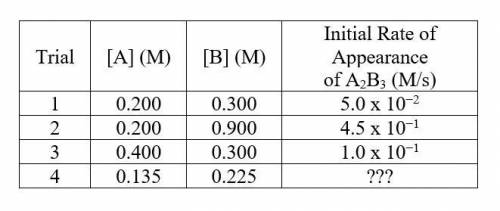
Chemistry, 11.02.2021 02:10 blessednish86orogbi
Answer questions 1-6 using the information below:
2 A(aq) + 3 B(aq) LaTeX: \longrightarrow⟶ A2B3(aq)
An experiment is conducted at 25 C and the rate of appearance of the product A2B3(aq) is measured as the concentrations of the reactants were varied. Data from the trials are shown below: -picture-
1. Determine the rate law for the reaction at 25 C. Justify your answer.
2. Determine the value of k, including units.
3. Determine the rate of trial 4.
4. A possible reaction mechanism has a 1st elementary step as shown below:
A + B ⟶ AB
Could this first step be the rate determining step? Explain your reasoning.
5. In the reaction mechanism, the compound MnO2 appears. A student makes the claim:
"The order of MnO2 must be zero since it does not appear in the overall balanced equation."
Do you agree or disagree with the student? Explain your reasoning.
6. In trial 1, 10 mL of A and 10 mL of B are mixed and the reaction goes to completion.
i.) Determine the number of moles of B used in the reaction.
ii.) The reaction vessel is heated and all the water is driven off, leaving only 0.124 grams of A2B3(s). Determine the molar mass of A2B3.


Answers: 3
Another question on Chemistry


Chemistry, 22.06.2019 03:30
In this chemical reaction, 325 grams of barium (ba) react completely. how many moles of lithium (li) are produced?
Answers: 1

Chemistry, 22.06.2019 06:30
Suppose a lab group reports a ppercent yield of sand of 105. is it really possible to collect more sand than was originally represented? what is the possible explanation for the extra product?
Answers: 2

Chemistry, 22.06.2019 07:50
Many reactions take place in aqueous solution. when potential reactants are mixed, a reaction will occur if there is some driving force that favors the formation of products. it is often convenient to categorize reactions in terms of these driving forces: precipitate formation, in which an insoluble solid is formed, weak electrolyte formation, as in a neutralization reaction involving water, or transfer of electrons, as in a redox reaction. these reactions can be represented by full molecular equations, which contain all species in the reaction mixture, or by net ionic equations, which show only the species that actually undergo a change. the latter does not contain the spectator ions, which do not undergo a net change or do not take part in the reaction. part a when the following two solutions are mixed: k2co3(aq)+fe(no3)3(aq) the mixture contains the ions listed below. sort these species into spectator ions and ions that react. drag the appropriate items to their respective bins. view available hint(s) spectator ions ions that react part b what is the correct net ionic equation, including all coefficients, charges, and phases, for the following set of reactants? assume that the contribution of protons from h2so4 is near 100 %.ba(oh)2(aq)+h2so4(aq)→ express your answer as a chemical equation. view available hint(s) nothing provide feedback
Answers: 3
You know the right answer?
Answer questions 1-6 using the information below:
2 A(aq) + 3 B(aq) LaTeX: \longrightarrow⟶ A2B3(aq...
Questions


Mathematics, 05.08.2019 00:30


Biology, 05.08.2019 00:30


History, 05.08.2019 00:30

Social Studies, 05.08.2019 00:30

Computers and Technology, 05.08.2019 00:30

Computers and Technology, 05.08.2019 00:30


Mathematics, 05.08.2019 00:30

Mathematics, 05.08.2019 00:30





Computers and Technology, 05.08.2019 00:30

Computers and Technology, 05.08.2019 00:30




